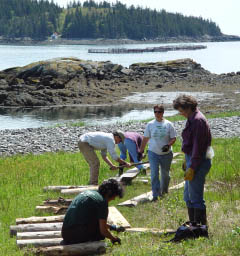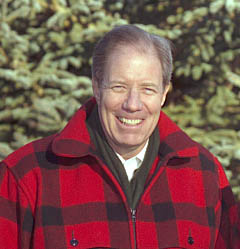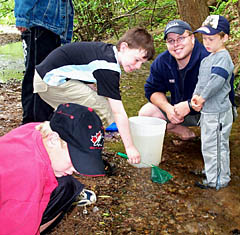|  Staff and volunteers on Western Head
Photo: Warren Whitney | | Maine Coast Heritage Trust
Topsham, Maine In the face of intense pressures for development along the coast, Maine Coast Heritage Trust (MHCT) has been the leading private land conservation organization since 1970. During that time it has conserved more than 119,000 acres of land, including 245 entire coastal islands. In 2004 it completed more than 30 land protection projects. They include wild offshore islands, wetlands and stream frontage that are important for wildlife habitat, community recreation and working farms. MCHT created the Maine Land Trust Network for information sharing and technical assistance for local land trusts throughout Maine and into Maritime Canada. It also collaborated with others to establish the Land Trust Alliance, a noted national organization. The MCHT works with landowners using various conservation techniques to protect land considered essential to the character of Maine. All of the agreements with landowners are voluntary, and some include purchases, such as 78-acre Saddleback Island in the Deer Isle Thorofare, which the trust recently protected for the public. It also recently partnered with the Bar Harbor Housing authority to protect a 167-acre saltwater farm adjacent to Acadia National Park. “We continue to work with landowners to facilitate their passion for land conservation,” says Richard Knox, MCHT’s director of communications. One of the Trusts’ more notable achievements took place in 1988, when MCHT worked to preserve three bold and pristine coastal headlands that were threatened by proposed residential development. News of the planned development drew public outcry. The three headlands—Western Head, Great Head and Boot Head—are in easternmost Maine near the Canadian border. Western Head supports one of Maine’s last inshore herring beds, a critical supply of bait for local fishermen. MCHT’s board acted quickly, launching a $5-million campaign and partnering to secure the headlands and assure permanent public access. |  Edward McLean
Courtesy of Connors Bros. Ltd. | | Edward McLean
Saint John, New Brunswick The well-being of juvenile herring in the Bay of Fundy started Edward McLean’s notable work on sustainable development of the fishing industry in the Gulf of Maine. As the former executive vice president of sardine operations for Connors Brothers, McLean became keenly aware of the delicate balance between preserving fish and their environment and meeting the needs of people whose activities can cause pollution. The century-old company obtains 95 percent of its juvenile herring, which it packages and sells as sardines, from the Gulf of Maine. It is the only sardine packer left in North America. “We have seen the business failures caused by overfishing, like cod in Eastern Canada,” says McLean, who retired from Connors at the end of 2004 after serving for 37 years in various executive positions. “The juvenile herring are very important to us, as is the environment in which they grow and survive.” McLean said Connors saw the exploitation of fisheries in the 1960s and 1970s, when herring were used for fishmeal to feed chickens. Fishmeal producers had such a tremendous capacity to catch and process fish that Connors and the government realized the herring population could be in jeopardy, and the practice was stopped. Currently, pollution and the use of herring for lobster bait pose immediate challenges. McLean and Connors have worked with the government to identify sites and pollution, and they are encouraging fishermen to listen to scientists’ biomass estimates to avoid overfishing the critical resource. They also have worked with the salmon aquaculture industry to find ways the two industries can coexist. McLean became involved in fisheries in a broader way when he served as New Brunswick’s private-sector member on the Gulf of Maine Council for five years. |  Jim Irving, President of J.D. Irving
Courtesy J.D. Irving Ltd. | | J.D. Irving Ltd.
Saint John, New Brunswick J.D. Irving Ltd. (JDI) decided two heads were better than one when it teamed up with Deborah MacLatchy, associate professor of biology at the University of New Brunswick in Saint John. JDI discovered that MacLatchy was researching the impact of effluent on the estuary around JDI’s pulp mill, and invited her into the mill because it also was working to prevent pollution, says Bill Borland, director of environmental affairs for the company. “We were putting a lot of effort into pollution prevention, which is a better long-term investment than secondary treatment,” Borland says. Of key concern was the endocrine disrupting chemicals found in the mill’s effluent. The chemicals, which have been linked to reproductive and other problems in fish, are a component of the trees processed by JDI. The company installed a reverse osmosis treatment using a high-pressure membrane to clean up the effluent. MacLatchy examined the water after the treatment and found no endocrine disruptors in it. JDI, a family business started more than 100 years ago, makes environmental friendliness a business practice. “There is a long list of things that we do,” Borland says, such as salmon restoration work in rivers, right whale protection in the Bay of Fundy and work in watersheds and coastal areas of the Gulf of Maine. JDI also has donated land in the Musquash Estuary in the Bay of Fundy to the Nature Conservancy, and established the 600-acre Irving Nature Park to preserve wildlife and ecosystems. In 1957, K.C. Irving, considered the patriarch of JDI and the person whose vision prompted the company’s environmental focus, started planting trees to foster sustainable forest management. “He wanted the company to do business as if it would be doing business for 1,000 years,” Borland says. |  Derick Fritz with Fish Friends on Elderkin Brook, Nova Scotia
Courtesy D. Fritz | | Friends of the Cornwallis River Society
Kentville, Nova Scotia The Friends of the Cornwallis River Society (FOCS) has spent more than a decade protecting and restoring the Cornwallis River watershed and developing a fisheries management plan for the Cornwallis River, a 45-kilometer stream that runs through the Annapolis Valley. Among the group’s many efforts are riparian re-establishment, fencing and leasing. The livestock-fencing program in Kings County, called the Cornwallis River Riparian Management Project, has been undertaken with the Nova Scotia Department of Natural Resources and the Nova Scotia Eastern Habitat Joint Venture Riparian Management Project. The program aims to restrict livestock access to habitats alongside the stream in order to reduce the degradation of riverbanks and improve the water quality. FOCS also is involved in creating riparian edges that help conserve wildlife habitat and reduce contamination from agricultural runoff. Once farmers see the results, they are quick to react to the benefits of the program. “People started talking about it after they saw that their neighbor had a nice riparian edge along the water,” says Derick Fritz, a fish biologist and acting executive director of FOCS. “Otherwise, they could be losing up to four feet of property a year.” FOCS also would like to repopulate the Atlantic salmon in the Cornwallis River. The two major tributaries of the Cornwallis River, Elderkin Brook and MillBrook, were well known for salmon, but the population dropped because of overfishing, overpredation and water-quality problems Other FOCS initiatives include volunteer water quality monitoring and promotion of awareness of fish and fish habitat within local elementary schools. Fritz emphasizes the importance of groups like FOCS partnering with other action-oriented organizations, especially at the community level. “One problem is groups are not able to move forward without the support of others,” he says. |  Sherman Bleakney
Photo: Andi Rierden | | J. Sherman Bleakney
Wolfville, Nova Scotia “I’ve
had a whole life of discovery,” says J. Sherman Bleakney, a
distinguished zoologist, marine biologist, researcher, historian
and writer who has spent the past 50 years finding out what is in
the Bay of Fundy. A retired Acadia University biology professor,
Bleakney modestly says his primary contribution is baseline data
about the bay. But his insatiable curiosity has yielded the first
chronicles of the lives and habits of multitudes of previously unknown
creatures.
Among his seminal work was the discovery of leatherback sea turtles
in the North Atlantic, and the fact that they feed on stinging jellyfish
rather than on crabs, as had been thought. His work earned him the
honor of a namesake: the first male leatherback tagged with a satellite
transmitter was called “Sherman.” But Bleakney is hard-pressed
to name a favorite discovery; there have been so many, and there
will be more in the future. He was excited to find flying squirrels
in Nova Scotia, frogs that smell like minks and a 3,800-year-old
bed of preserved oysters in Minas Bay.
His books are “Sea Slugs of Atlantic Canada and the Gulf of Maine,” “Keys to the Fauna and Flora of Minas Basin,” and “Sods, Soils, and Spades: The Acadians at Grand Pré and their Dykeland Legacy.” He calls the Acadians book a retirement hobby that he wrote from 1994 to 2004. He looked at maps from the early 1800s and talked to 80-year-olds who still remembered the dyking methods of the Acadians. He still marvels at their skills. “They dyked 250,000 acres with a spade, pitchfork and a pair of oxen,” he says. “They dyked just about every stream or river and farmed. They knew a lot about the tide cycles and rising sea levels.” | © 2005 The Gulf of Maine Times |

